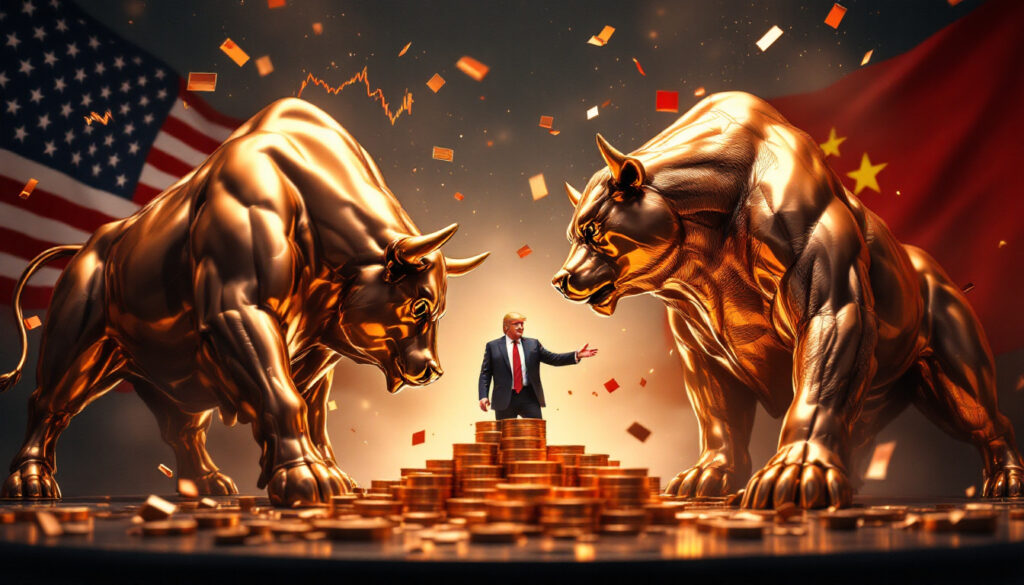How Are Trump's Tariffs Affecting the Copper Market?
The Dual Tariff Threat
The copper market faces a unique challenge from the intersection of macroeconomic trade tensions and sector-specific tariff risks. While existing U.S. tariffs on Chinese goods have disrupted manufacturing activity—a key driver of copper demand—the explicit threat of Section 232 tariffs on copper imports has created parallel supply chain disruptions. The CME premium over LME prices, which reflects U.S. import demand, oscillated violently from $1,600 per ton to $230 within a week before stabilizing above $1,000. This volatility underscores market uncertainty about both the timeline and magnitude of potential tariffs.
The Section 232 investigation, initiated in late 2024, has left traders in a race to stockpile copper in the U.S. before tariffs take effect. This behavior mirrors the aluminum and steel markets' responses to similar national security tariffs in 2018, though copper's widespread industrial applications amplify the stakes. Trump's policy impact had already increased copper's strategic importance, making current tariff tensions particularly consequential for long-term supply planning.
Market Volatility Indicators
Copper's price movements have exhibited hallmarks of speculative positioning unwinds. The LME three-month contract's 11% drop on April 7 marked the largest single-day decline since the 2020 pandemic shock, with trading volumes doubling the 30-day average. Time-spreads flipped from contango to backwardation multiple times during this period, reflecting competing pressures from physical delivery demands and financial liquidations.
Analysts have revised forecasts downward, with Citi projecting a three-month target of $8,000 per ton, citing parallels to the 2015 commodity deflation cycle. However, this outlook conflicts with micro-level supply tightening, as exchange inventories continue to drain. The dichotomy between copper price dynamics and physical market tightness suggests sustained volatility as traders reconcile these forces.
What's Happening to Global Copper Supply Chains?
U.S. Inventory Buildup
Anticipating tariffs, traders have accelerated copper shipments to CME-approved warehouses. Daily inflows into New Orleans facilities averaged 2,000 metric tons throughout March 2025, while Baltimore's dormant warehouses received 6,000 tons—their first activity since 2012. Total CME stocks reached 119,772 short tons by mid-April, the highest since December 2018. This stockpiling aims to mitigate tariff-related costs, but risks creating localized gluts if demand falters.
The inventory surge has distorted regional premiums. The U.S. Midwest premium, which typically tracks manufacturing activity, became decoupled from underlying demand indicators as logistical constraints at Gulf Coast ports compounded speculative inflows. This artificial inflation of U.S. stockpiles contrasts sharply with tightening availability elsewhere, particularly in China.
Global Inventory Shifts
While U.S. inventories swell, LME warehouses have seen sustained withdrawals, with on-warrant stocks falling to 116,250 tons—a nine-month low. This divergence reflects traders redirecting metal from London to New Orleans to capitalize on the CME premium. Similarly, Shanghai Futures Exchange (ShFE) inventories peaked lower and earlier than seasonal norms at 268,337 tons in February before plummeting 43,000 tons in a single week. The Yangshan premium, a bellwether for Chinese import demand, surged from $35 to $87 per ton, indicating domestic supply tightness despite elevated export volumes.
Chinese Export Patterns
Chinese smelters have increased refined copper exports by 98% year-on-year to 50,000 tons in early 2025, with 1,200 tons shipped directly to the U.S. This export surge, driven by arbitrage opportunities from the CME premium, risks depleting Chinese inventories despite robust domestic demand. According to recent analysis from Reuters, the strategy mirrors 2018 tactics used during aluminum tariffs, where producers rushed exports before tariff deadlines. However, this time, the broader U.S.-China trade war complicates logistics, as vessels face extended delays at congested ports.
Why Is Copper Called "Doctor Copper"?
Economic Diagnostic Capabilities
Copper's nickname stems from its sensitivity to industrial cycles, as its applications span construction, electronics, and renewable energy. The current price volatility reflects diagnostic uncertainty: plummeting prices signal fears of manufacturing contraction, while inventory draws suggest resilient underlying demand. Citi analysts note similarities to 2015, when copper's slide to $4,000/ton presaged global deflationary pressures. Today's market faces a paradox—tight physical availability amidst macroeconomic pessimism—making copper's prognostic value ambiguous.
The metal's role as a barometer is further complicated by speculative financial flows. Algorithmic trading programs, which accounted for 45% of LME volume in 2024, amplify price swings, potentially distorting copper's economic signaling function. This raises questions about whether current prices reflect true supply-demand dynamics or speculative positioning.
What's the Outlook for Copper Markets?
Conflicting Market Forces
The copper market and Trump's tariffs are caught between opposing macro and micro trends. Macro concerns center on tariff-driven demand destruction, particularly if the U.S.-China trade war escalates. The International Monetary Fund estimates that a 10% hike in global tariffs could reduce copper demand by 2.5% annually through 2030. Conversely, micro-level factors—including transport bottlenecks and inventory shifts—support prices by constraining immediate availability.
This tension is evident in forward curves. The LME three-month contract's discount to one-year futures widened to $150/ton in April, indicating expectations of prolonged surplus. However, physical traders report difficulties sourcing spot metal, with Chilean miners prioritizing long-term contracts over spot sales.
Potential Scenarios
Two primary scenarios dominate analyst projections:
-
Tariff Implementation: If Section 232 tariffs are enacted at 10-25%, U.S. premiums could spike to $2,000/ton, incentivizing smelter investments in tariff-exempt countries like Canada. However, this would fragment global trade flows, increasing costs for downstream manufacturers.
-
Status Quo Maintenance: Prolonged tariff threats without implementation could sustain current volatility, as traders balance speculative positioning against physical market signals.
Renewable energy demand remains a wild card. The International Energy Agency estimates that global commodity insights show green energy projects will require 5.5 million tons of copper annually by 2030—equivalent to 20% of 2024 production. Tariffs that raise copper prices could delay solar and wind deployments, creating feedback loops between energy policy and metal markets.
FAQ About Copper Markets and Tariffs
How Do Tariffs Typically Impact Commodity Prices?
Tariffs generally suppress demand by raising end-user costs, but their impact varies by commodity elasticity. The copper market and Trump's tariffs create a complex dynamic where inelastic demand in critical sectors (e.g., power grids) may limit consumption declines, but substitution risks loom. Aluminum conductor use in electrical applications, which rose 15% during the 2018 tariffs, could accelerate if copper prices surge.
What Indicators Should Investors Watch?
Key metrics include:
-
Exchange Inventories: Divergences between LME, CME, and ShFE stocks signal regional imbalances.
-
Premiums: The Yangshan and U.S. Midwest premiums reflect immediate regional demand.
-
Manufacturing PMIs: April's U.S. PMI drop to 48.7—the first contraction since 2020—warrants close monitoring.
How Might Tariffs Affect Industry Sectors?
-
Construction: Copper-intensive electrical systems account for 40% of U.S. construction material costs; tariffs could add $15,000 to average home build expenses.
-
Electronics: PCB manufacturers face cost-push inflation, with copper foil prices up 12% year-to-date.
-
Renewables: Solar farm developers report project delays due to uncertain pricing, jeopardizing 2030 climate targets.
In conclusion, the copper market and Trump's tariffs represent a significant challenge for investors navigating both geopolitical market strategies and copper smelting trends. As industry experts note, the trajectory hinges on resolving the tension between macroeconomic headwinds and microstructural shortages while preparing for supply chain realignments that could reshape global copper trade for decades.
Want to Stay Ahead of Major Mineral Discoveries?
Discovery Alert's proprietary Discovery IQ model provides instant notifications about significant mineral discoveries on the ASX, delivering actionable insights for both short-term traders and long-term investors. Explore why historic discoveries can generate substantial returns by visiting our dedicated discoveries page and begin your 30-day free trial today.




